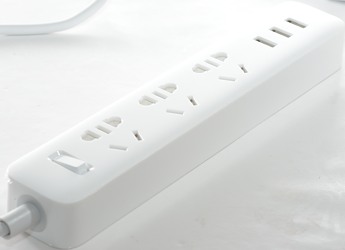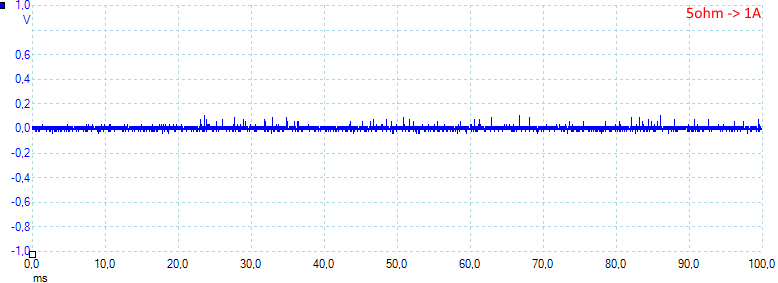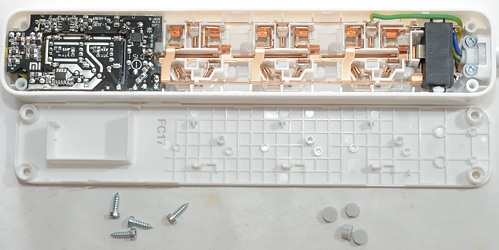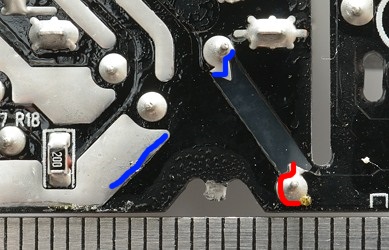Xiaomi 3 USB Power Strip

Official specifications
- Port: 3USB+ 3 Internation combination power jack
- Brand: Xiaomi
- Fast charge
- Overload protection: 10A
- Rated input: 10A, 250V
- Rated output: 10A, 250V
- Rated power: 2500W
- USB module input: 100-240V, 50/60Hz, 0.5A
- USB module output: single USB, 5V 2.1A(TYP)
- Three USB, 5V 3.1A(TYP)
- Use of the environment temperature: -10°C ~ +40°C
- Safety resistance: 75N
- Support 2A fast charger
- Weight: 300g
- Product Length: full-length 1.8m
- Size: 22.5cm*4.1cm*2.6cm
I bought this from Banggood

The charger/power strip was in a long box.

It contained the charger/power strip and a instruction page in probably Chinese and Chinese 3 pin plug.

The mains socket can mate with EU / US 2 pin plugs.



Measurements
- The mains plug is a Chinese plug with earth.
- Universal sockets on the strip do not fit UK plug or any EU/US earthed connections.
- With power strip turned on, but unloaded it uses 0.2 watt
- All Usb outputs is with auto coding up to Apple 2.1A
- Usb outputs are in parallel.

The output voltage drops slightly when loaded and then stays fairly stable. There is overload protection at 3.3A.

Same on this socket.

Running all 3 socket in parallel shows that the overload protection is common for all 3 socket, i.e. the total current is 3.3A before the protection kicks in. This means you have to be careful with what devices are connected to the usb power too stay below 3.3A.

One hour with 3.1A load is not a problem.
The temperature photos below are taken between 30 minutes and 60 minutes into the 1 hour test.

HS1: 67,6°C
HS1 must be the mains transformer.

M1: 48,2°C, M2: 38,8°C, M3: 38,0°C, HS1: 56,6°C
Here HS1 looks to be the mains switch transistor.

M1: 57,8°C, M2: 45,1°C, HS1: 63,3°C
M1 is the rectifier IC.

M1: 49,1°C, HS1: 49,9°C

M1: 48,0°C, M2: 49,7°C, HS1: 71,8°C
HS1 is the mains transformer.

At 0.5A the noise is 12mV rms and 280mVpp, this is fairly low.

At 1A the noise is 13mV rms and 207mVpp

At 3.1A the noise is 25mV rms and 390mVpp, even at full load the noise is acceptable.
A short look at the power strip
The specifications says it has overload protection, is that correct?

The answer is yes, with 40A current it trips in about 1 seconds.

With 20A it is about 10 seconds.

And at 13A it is about 4 minutes. These trips times looks very resonable.
All test was done with a low DC voltage.
Tear down

Beneath the feets was four screws, but that was not enough to open it. Around the edge was a lot of locks that had to be opened.

On this side there is a input fuse, a common mode coil, a inductor and the mains switch transistor on the mains side. There is a safety capacitor between mains and low volt side, but nothing of interest on the low volt side.

On this side we have the mains rectifier bridge (BD1) and the mains switcher controller (U1). On the low volt side there is two chips to handle the automatic coding of usb (U3 & U4), but there is no rectifier diode. Instead there is a synchronous rectifier chip (U2).

On this side is the fuse (Brown block) and the safety capacity (Blue).


The common mode coil and the transformer are mounted at the ends.

The mains switch transistor and the inductor can be seen here.


The black box is the switch with the automatic fuse. All connections inside and the sockets are done with unisolated metal.

There is done a lot for safety in this power strip/usb power supply. The first part is the cutout and plastic shield in the circuit board, that handles nearly all creepage distances, including a good safety margin.


At the end of the cutout, there is also enough distance.

On the other side there is the distance from the mains switch transistor to the usb connector, it must be 4mm and is just about that. Note: The plastic shield is also present in the top part of the power strip and will keep the transistor away from the usb connector.
Testing the mains input with 2500 volt and 5000 volt between mains and low volt side, did not show any safety problems.
Conclusion
Just about everything looks fairly good on this power strip, but I have a few complains:
3A is not much current to share between 3 usb sockets, especially not when they all will report 2.1A capacity.
I would have liked if it could handle earthed connections for EU plugs, but that would probably spoil the versatility for other plugs.
If you can live with the limited usb power and the accepted mains plugs I believe it is a good power strip/usb charger, but it will probably be a good idea to replace the mains plug with one for your area.
Notes
Index of all tested USB power supplies/chargers
Read more about how I test USB power supplies/charger


































